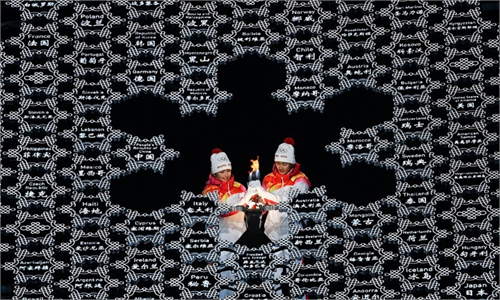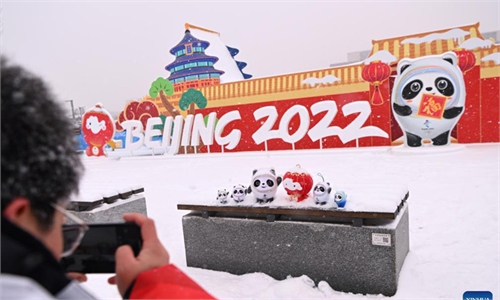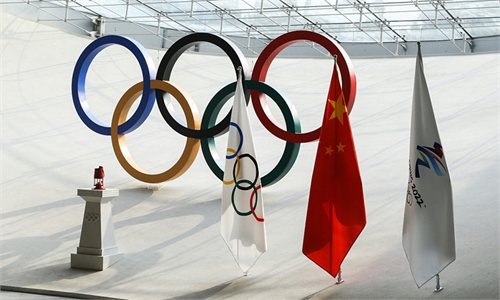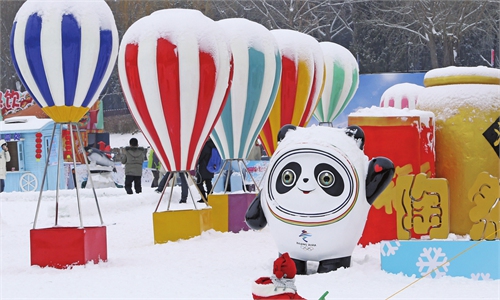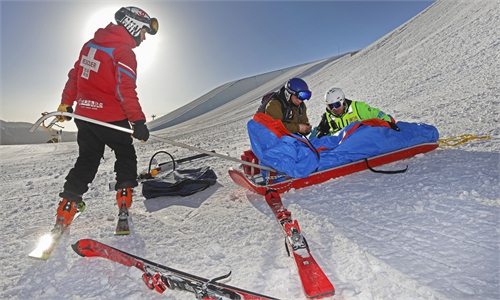Beijing’s high-tech Olympic venues add ‘wings’ to athletes
Nation’s innovation helps deliver promise of a spectacular Olympics
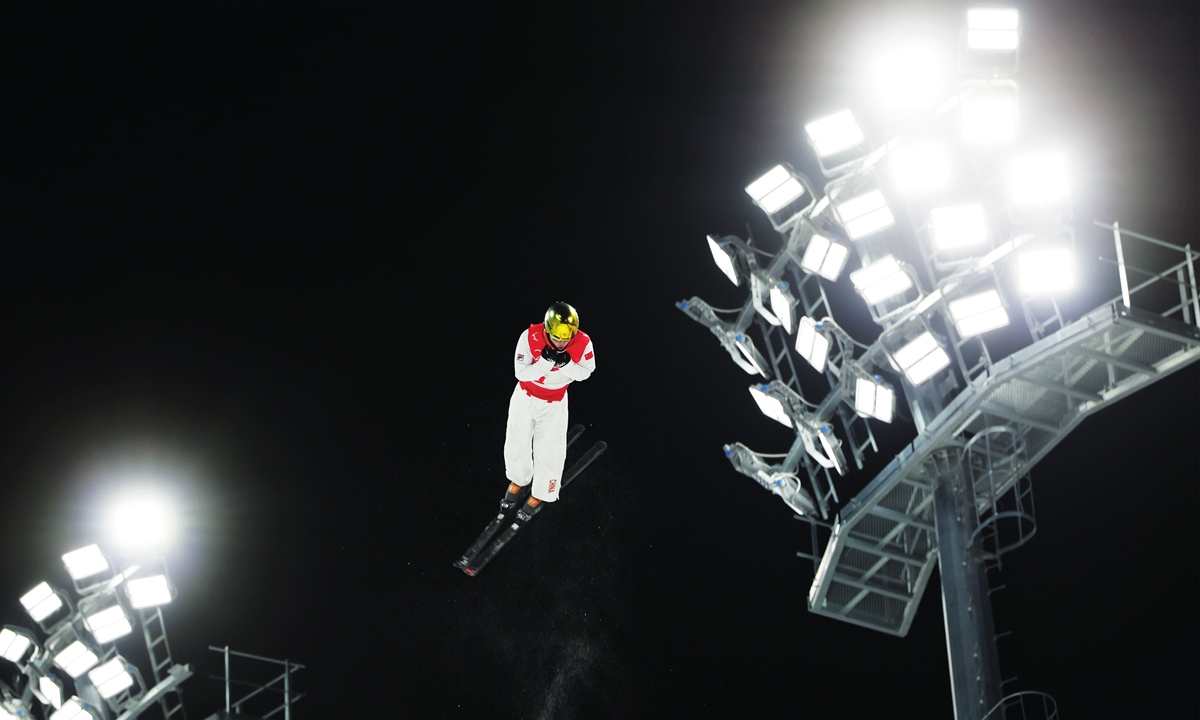
Qi Guangpu of China competes during the freestyle skiing men's aerials final of the Beijing 2022 Winter Olympics at Genting Snow Park in Zhangjiakou, north China's Hebei Province, February 16, 2022. Qi scored 129 points to win the men's aerials gold in his fourth Olympic appearance. Photo: Cui Meng/GT
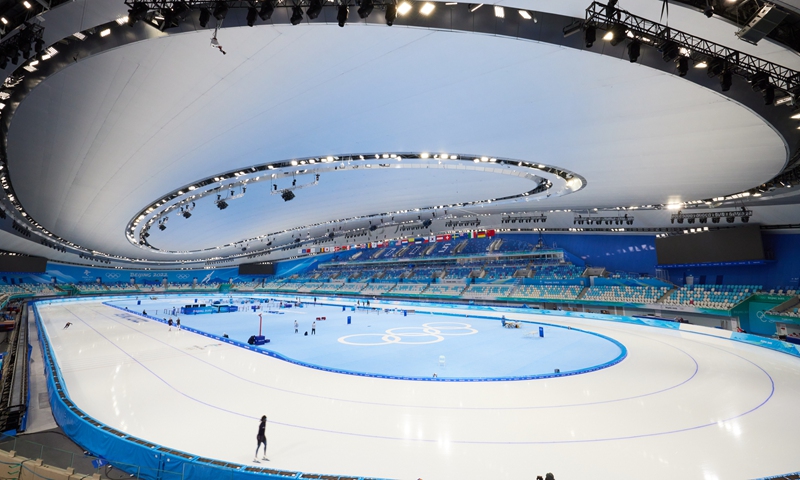
The National Speed Skating Oval, also known as the "Ice Ribbon" Photo: VCG
Halfway through the Beijing 2022 Winter Olympics, athletes from all over the world have gone on and on renewing their personal records, breaking and setting new Olympic records and world records in various venues in China. Behind such faithful practices of the Olympic motto of "Faster, Higher, Stronger - Together," Beijing's high-tech venues have played a crucial role in the athletes' pursuit of career ambitions.
In short track speed skating in the Capital Indoor Stadium, eight Olympic records have been set, including for the Women's 500 meters by Dutch skater Suzanne Schulting and one for the Men's 1,000 meters by South Korean legend Hwang Dae-heon. Schulting also set a world record in the Women's 1,000 meters quarter-final Stage 1.
Likewise, the National Speed Skating Oval, also known as the Ice Ribbon, witnessed the birth of even more Olympic and world records. Athletes from the Netherlands, Sweden, China, Japan and the Russian Olympic Committee set 12 Olympic records and one world record.
Gao Tingyu of China claimed the gold in the Men's 500 meters with a new Olympic record of 34.32 seconds, bagging the first ever gold in China's men's speed skating history, creating one of the most memorable moments.
Fastest ice
Yang Shu'an, vice president of the Beijing Organizing Committee for the 2022 Olympic Winter Games (BOCOG), hailed the 12,000-square-meter rink of Ice Ribbon as the "fastest ice" in the world for its contribution to the athletes' amazing performances.
In speed skating, in which athletes achieve the fastest speed without assistance, the less the difference in temperature and the evener and flatter the ice surface would get contributed to better performances, the Global Times learned from insiders.
"In constructing the Ice Ribbon, the primary goal was to facilitate improved performance," said Ye Maosheng, an associate professor of physical education at China University of Mining and Technology in Beijing, said in an interview with China Central Television (CCTV).
Looking back at the Winter Olympics history, technological advances in skating arenas have led to two leaps in athletes' performances.
In 1965, the first artificial frozen rink, Max Aicher Arena, was built in Inzell, Germany. In the following decade, it witness 42.4% of the world records in 10 years. In Calgary 1988 Winter Olympics, the first completely enclosed indoor speed skating arena was applied. The speed skaters reset 10 Olympic records and 6 world records there.
To help athletes achieve their best performances in Beijing with another technological leap, the Ice Ribbon has, for the first time, advanced carbon dioxide trans-critical direct cooling ice-making technology. Compared to the traditional technology, the new way has a 20 percent better efficiency and with seamless stainless steel pipes laid under the ice surface, the liquid carbon dioxide flowing in the steel pipes can ensure that the temperature difference on the ice surface does not exceed 0.5 C, Ma Jin, head of the ice-making design team, told the Global Times.
In addition to the ice technology, the design of the arena enhanced the performance of the athletes.
The ring-shaped auditorium completely wraps around the track to help keep athletes excited. At the same time, the hyperbolic roof creates a better sense of space and helps athletes focus more on the track.
From the athletes' perspective, the roof is higher at the exit of the curve, making it feel more open and spacious. When the athletes approach the curve, the roof is closer to the ice, allowing athletes to feel more in control of the course, said Zhang Hong, China's first gold medalist in speed skating, after visiting the Ice Ribbon, according to CCTV.
"It's one of the best speed skating rinks in the world, and I can get a good result here to stand on the podium, I am very happy," said Japanese speed skater Miho Takagi, who won three medals at the Beijing Winter Games.
The venue's construction played a role in the athletes' outstanding performances in the Ice Ribbon, said Zhao Weidong, the spokesperson of the Beijing Organizing Committee.
With three game days remaining, the Ice Ribbon has witnessed the most frequent breaking of Olympic records in speed skating at 12 times among the latest four Winter Games, more than 8 times in PyeongChang 2018, 9 times in Sochi 2014 and 5 times in Vancouver 2010.
Xu Qiang, director of the Beijing Science and Technology Commission, said at a Wednesday press conference in Beijing that the Ice Ribbon has won praise from the International Olympic Committee as well as the International Skating Union.
According to Xu, more than 200 technologies have been tested and used for Beijing 2022 in over 60 disciplines, making the event safer from the pandemic, more environmental friendly and more spectacular.
Apart from speed skating, short track speed skating is another discipline where athletes kept breaking records in Beijing. As of Wednesday, Olympic records were reset eight times, with the Netherland's Suzanne Schulting setting a world record.
The Capital Indoor Stadium, the competition venue for short track speed skating, a historic stadium that saw the 1971 Ping Pong diplomacy and also was one of the competition venues for the 2008 Beijing Summer Olympics, underwent reconstruction prior to the Winter Olympics. It uses the same carbon dioxide ice-making technology as the Ice Ribbon.
In addition, the arena uses the latest sound and light technology to create the "most beautiful ice." As athletes skate, laser projectors at the corners of the arena project brilliant lights on a giant 1,332 square meter projection screen at the top of the arena, putting them in a world of ice and snow, Ding Dong, head of the venue's operations team, told the Global Times.
Chinese observers said that the great performance of athletes has not only delivered Beijing's promise of making the Beijing 2022 a "spectacular" one, but also showcased the strength of China's innovation.
Apart from the "fastest ice," high-tech elements are everywhere in the Beijing 2022 Winter Olympics, ranging from the robotic chef in the Olympic village, the hydrogen fueled shuttles, the bullet train connecting Beijing and Zhangjiakou competition zones, to the referee system camera.
More than speed
Records aside, many of the venues in Beijing have been praised by visiting Olympians and officials.
Thomas Bach, president of the International Olympic Committee, told the media that the Beijing venues are so outstanding that all athletes are content and some of them compared the venues to heaven.
Yuzuru Hanyu, world-renowned Japanese figure skater, spoke highly of the venues of the Beijing Winter Olympics, saying both "the stadium and the ice are brilliant" and "I like it here," according to the Xinhua News Agency.
American Samoa's skeleton athlete Nathan Crumpton said the Yanqing National Sliding Center is one of the most beautiful tracks he has seen in the world, wrapped around the mountains, with great facilities and easy access.
Bobsledder Carlo Valdes, a member of the US team, told the Global Times that "Compared to [South] Korea… you can tell that the organizers wanted to do a step up and try to make it better for athletes," he said.
"It's the coolest track I've ever experienced," he told the Global Times after checking the bobsled track in Yanqing, noting that it shows that the amount of time the organizing committee and staff put into the Games has really paid off.
The hi-tech construction of venues for the Beijing Winter Olympics is an important part of the event, laying the foundation for its success, observers noted.
"We insist on 'athlete-centeredness' and strive to build a safe, sound, professional and fair arena for athletes to compete in so that they can fully express their talents on the stage," said Zhao Weidong at a news conference.

